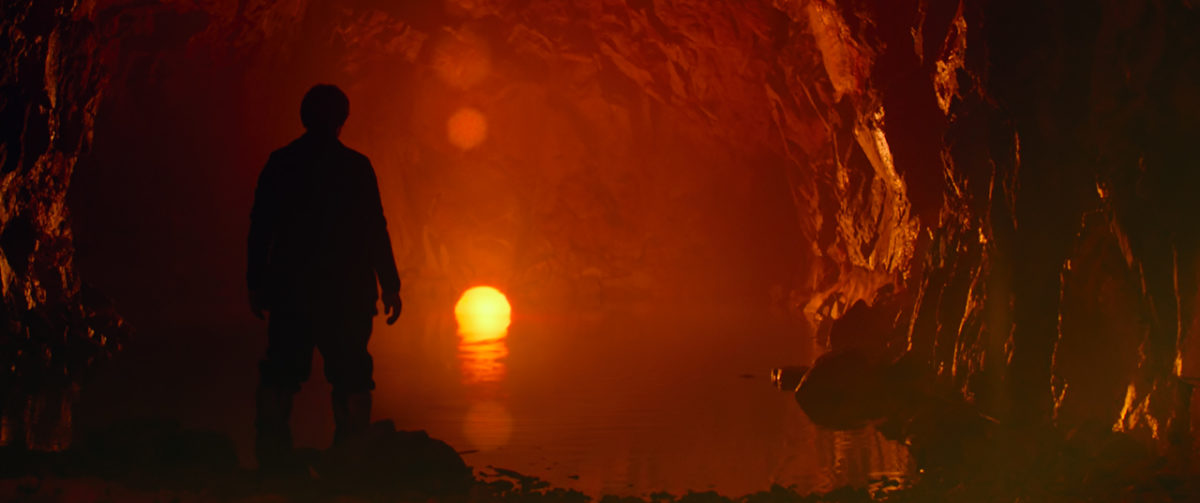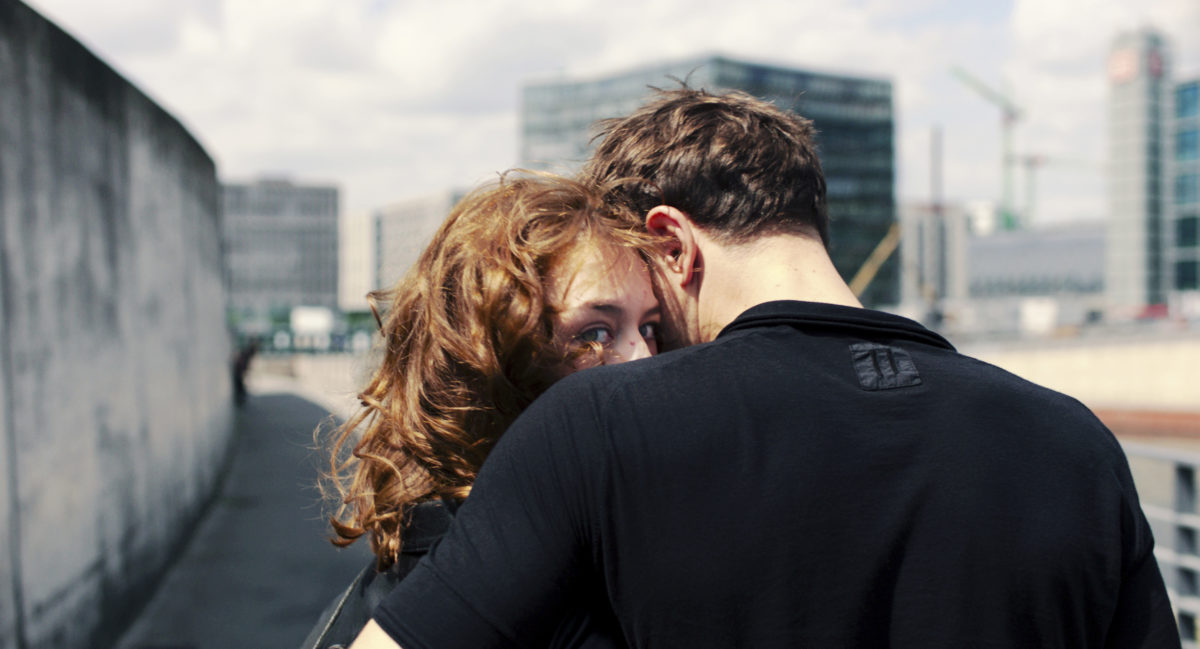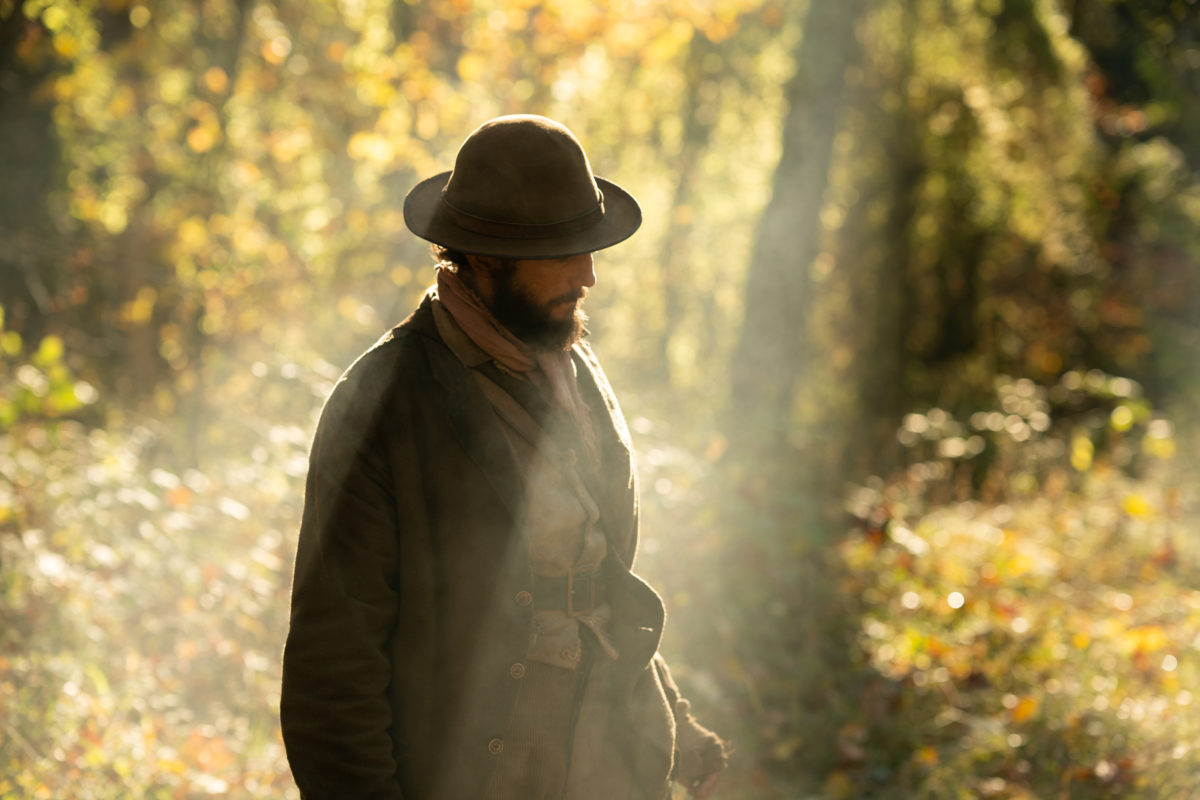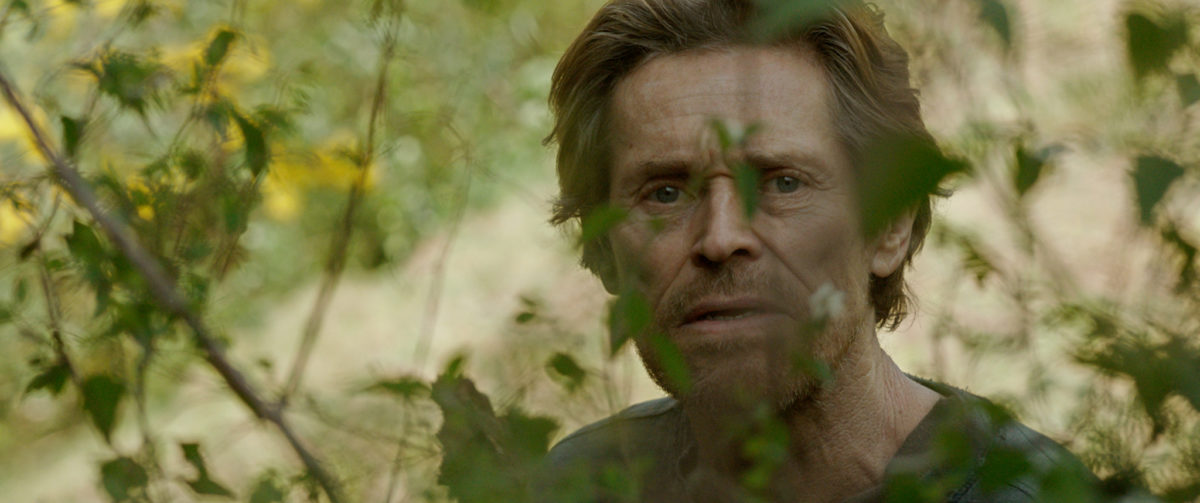Willem Dafoe, for some unexplained reason, has gone into exile in Siberia. He faces the tundra daily, often seen mushing Huskies hither and fro. We never really know where they—or the film—are ‘going’, nor does it really matter. His name is Clint. Before he starts mushing all over the place, he tends bar (because what else does one do at the end of the world?) for weary travelers and the occasional Babushka and her pregnant (adult) daughter. Only one other man who stops in speaks English, and he turns into a beast of some sort.
Most notable of Siberia’s formal decisions is its sheer fearlessness; Go-Pro shots of his hard-at-work huskies and dank cave interiors which work in-context mostly thanks to their being accompanied by pristine sound work of endless far-off rumbles, and other, sturdier imagery including—but not limited to—countless cross-dissolves of the moon. There is a string of human confrontations which seemingly bear little relation to one another apart from our protagonist’s presence; Clint ends up in the desert, briefly superimposed in space, and is visited variously by hallucinations of his father, mother, ex-wife, and a practitioner of black magic. Siberia is destined to oft be compared to The Tree of Life (Terrence Malick, 2011), yet opts for a much darker corner of personal headspace, as well as allowing for greater interaction between the concrete world and apparitions. Clint dances to Del Shannon’s ‘Runaway’ (the first 45 Dafoe ever owned), body swaying in and out of absolute shadow, then accompanied by a faded-in magician of the dark arts, until finally transported to a girl’s birthday party, running with a ribbon around a maypole among the youths.
Where myriad moving image works flaunt their ignorance of the avant-garde by simply cutting together rapid messes of incoherent shots as a failsafe means of representing otherworldly concepts, Ferrara is unafraid to tap into the tactic (in the instance of a brief werewolf (?) attack) in a more deliberately incoherent way: instead of helplessly shaking the camera and hoping for usably disorienting footage, he aims to disturb our bearing with purpose, to reflect Clint’s phenomenological field. While I don’t necessarily aim to give credit to Ferrara for any semblance of knowledge of the avant-garde, I think credit is due merely for his clarity of vision in presenting such a wild chimera of a work. Ferrara seems in his surreal visions to (inadvertently?) follow Brakhage’s maxim, “Nowhere in its mechanical process does the camera hold either mirror or candle to nature. […] Essentially, it remains fabricator of a visual language, no less a linguist than the typewriter.”

One scene sees Dafoe descending into a cave, only to find an anti-version of himself reflected on the water, wearing sunglasses. It is clear from the moment before the two iterations initiate conversation that they are something like yin and yang. Yes, I was reminded of Sam Raimi’s Spider-man (2002), in which Dafoe is asked to pull nearly the same act in playing Norman Osborne and his persona, the Green Goblin. It’s this marriage of abstraction and specificity, incoherence and purpose which raises Siberia above most other ‘lonesome guy on a headtrip’ titles. Having such a capable actor in the lead certainly doesn’t hurt either. Two further assertions from Brakhage seem to encapsulate what Siberia represents: that “the ‘absolute realism’ of the motion picture image is a contemporary mechanical myth”; and later on, that “the ‘absolute realism’ of the motion picture is unrealized, therefore potential, magic.” What we witness in Ferrara’s fever dream is the absolute realism of absolute fiction, and it is magic, all of this upheld by its sincerity. Siberia is often ridiculous, laughable, as vulnerability so often is when faced from a perspective of anything other than a matched vulnerability.

Interested in a more traditional rendition of magic, though told with a (mostly) straight face, Christian Petzold’s Undine offers a contemporary re-telling of the ancient elemental water beings of the same name. Our heroine (Paula Beer) lives in Berlin, where she works as a historian giving talks to tour groups on the city’s architectural history using scale models as visual guides. When we meet her she is heartbroken, but she soon finds a new love interest in Christoph (Franz Rogowski).
In Undine, it’s the copious train rides which briefly offer up their visual gift: the first time we see Berlin graffiti and trees whiz by in that all-too-familiar out-the-window view, I wrote it off as transitional filler. The second time it happened my experimental senses stated tingling. Then—a visualization of the Brakhagian concept which first melted my mind years ago: that smooth panning is an invention of the cinema camera, and not an accurate reflection of the way we actually look across a room, our eyes instead jumping from one point of interest to the next. We watch Undine watch the landscape fly by, eyes positively abuzz and pivoting from point to point, an image so powerful that I very nearly forgot about the rest of the film.

Not every avant-garde moment in this year’s competition was a serendipitous Brakhage-ism; Kelly Reichardt’s latest offers an explicit point of partial inspiration. First Cow delves into the primitive trapper-economy of early America, as Cookie (John Magaro) meets escapee King-Lu (Orion Lee), and the two begin a small business selling oiled cakes made using stolen milk from the premier Bos taurus to enter the country. Director Kelly Reichardt has built her career on stoic (though not detached) observations of human behavior. Shot on 35mm and presented in 1.37:1, First Cow reaches into the roots of America through its mise-en-scène as well as formalist choices. Its interest in an avant-gardist stillness is explicit from minute one, and its closing dedication to Peter Hutton does away with any potential doubt to this claim. Understandably, the film’s avant-garde interests lie further from Brakhage and the New American Cinema, closer instead to late-century landscape surveyors like Benning (and yes, of course, Hutton). There is however one obvious aesthetic distortion: a Vaseline-smeared lens-edge documenting several shots of a groggy middle-of-the-night awakening, a visual imperfection which brings to mind Brakhage’s comment that by “deliberately spitting on the lens or wrecking its focal intention, one can achieve the early stages of impressionism,” which the shots certainly do come close to, thanks as well to being paired with low light and soft focus.
On the press circuit for her previous film, Certain Women (2016), Reichardt offered an insightful glimpse of her appreciation for the avant-garde: “Well, the reason that I teach at Bard is because it’s a largely avant-garde program. I generally don’t let people take a narrative class with me until they’ve taken something with Peggy Ahwesh—an experimental feminist filmmaker—or a landscape class with Peter Hutton, who just passed away this summer. But Peter’s philosophy and approach to filmmaking, and to time and the littlest details of life—to have a student spend a semester with Peter, by the time they come to study narrative with me, they have a completely different outlook on film than they would have had. They don’t just wander into a narrative class with nothing. I’ve taught those kinds of classes, it’s insanely hard. At Bard, they’ve gone through an initiation process of a different way of experiencing the moving image. I’ve taught at NYU, for which I was just a bad fit. You get indoctrinated with Scorsese, and—nothing wrong with that, but it’s different.”
Hutton described his own moving image works in turns as travelogues and sketches, and shared with Benning an affinity for literally watching paint dry—they’ve both made similar assertions in post-screening talks. As a brief aside, in writing of Benning and Hutton, I would be remiss not to mention another title which played in the Forum section this year; Joshua Bonnetta’s The Two Sights, which too deals in observational landscapes shot on (Super) 16mm. Bonnetta studied at CalArts (where Benning teaches and shot his latest film, Maggie’s Farm, which also played in this year’s Forum). The Two Sights features a boat sequence which bears some resemblance in location and texture to Hutton’s At Sea (2007).
But enough about men—where has Reichhardt taken these starting points? Where Benning and Hutton are often devoid of characters, First Cow (like her previous works) combines a love of landscape with patient character observation, and while exchange of dialog is kept to a minimum, it is nevertheless present and pertinent. “History isn’t here yet,” notes King-Lu, “[…] we can take it on our own terms.” Here sincerity is channeled primarily through the dignifying of house chores. In one arresting sequence we see Cookie tidy up inside their humble cabin, as King-Lu chops wood outside, seen through the window frame (of course there is no actual window). During a bar brawl, Reichardt chooses to focus on a baby who unknowingly waits for the tumult to pass, rather than showing the conflict itself. Time and again, Reichardt’s affinity with the avant-garde lies in showing us what is typically overlooked.
Ultimately what do we gain from an influence on the part of the avant-garde? Nothing, if you view films as functional message-carrying tools. Everything, if you view films as means of investigating life, a means of learning how to look.
NOTES
(For an in-depth look at Hutton’s career, readers may enjoy Michael Sicinski’s piece for Cinema Scope.)
(All Brakhage quotes taken from ‘The Camera Eye’ essay in Metaphors on Vision, the pages of which are not numbered in my edition…)
